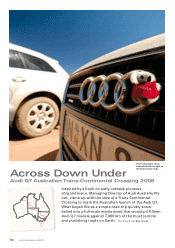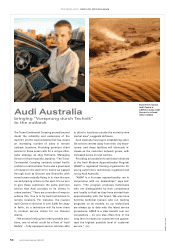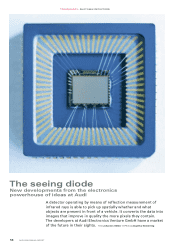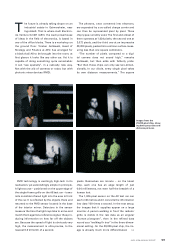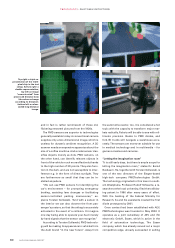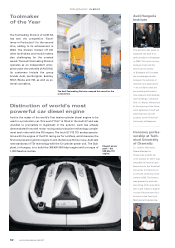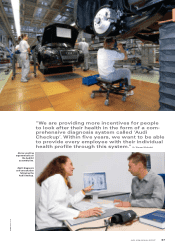Audi 2006 Annual Report Download - page 61
Download and view the complete annual report
Please find page 61 of the 2006 Audi annual report below. You can navigate through the pages in the report by either clicking on the pages listed below, or by using the keyword search tool below to find specific information within the annual report.
pixels themselves are minute – on the latest
chip, each one has an edge length of just
0.04 millimetres, not even half the breadth of a
human hair.
The 1,024-pixel sensor on the A8 test car can
see for 40 metres and it converts the information
into data 100 times a second. In the test setup,
the images that it supplies appear on a large
monitor. A person walking in front the radiator
grille is visible in the raw data as an angular
“human pictogram”, then in the refined data
record as a “walking fir tree” in the three-dimen-
sional setting. On the 29,200-pixel chip, the im-
age is already much more differentiated,
Images from the
29,200-pixel chip, show-
ing both grey value and
distance pictures.
>>
59AUDI 2006 ANNUAL REPORT
The future is already taking shape on an
industrial estate in Gaimersheim, near
Ingolstadt. That is where Audi Electron-
ics Venture GmbH (AEV), the Audi powerhouse
of ideas in the field of electronics, is based in
one of the office blocks. There is a workshop on
the ground floor. Torsten Gollewski, Head of
Strategy and Finance at AEV, has arranged for
a black Audi A8 to be brought into the room; at
first glance it looks like any other car. Yet it is
capable of doing something quite remarkable:
it can “see spatially”, in a radically new way.
Not with the aid of cameras or radar, but with
photonic mixer devices (PMD).
The photons, once converted into electrons,
are separated by a so-called charge carrier and
can thus be represented pixel by pixel. Three
chip types currently exist. The first and oldest of
them operates at 1,024 pixels, the second one at
3,072 pixels, and the third one at an impressive
29,200 pixels, packed into a silicon surface meas-
uring less than one square centimetre.
“The number of pixels compared to a digi-
tal camera does not sound high,” remarks
Gollewski, but then adds with fatherly pride:
“But then those chips can only see two-dimen-
sionally. In our diode, every single pixel takes
its own distance measurements.” The square
PMD technology is excitingly high-tech in its
realisation, yet astonishingly simple in principle.
A light source – positioned on the upper edge of
the single-frame grille on the A8 test car – trans-
mits invisible infrared light into the area in front
of the car. It is reflected by the objects there and
returned to the PMD sensor located in the base
of the interior mirror. Detectors in the sensor
measure the time the light rays take to arrive and
match them against a reference signal, thus pro-
ducing information on how far off the objects
are. Because the speed of light is obviously very
high, the measurement is ultra-precise, to the
nearest 6.6 trillionth of a second.



